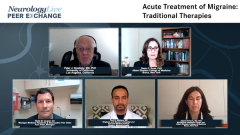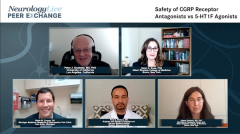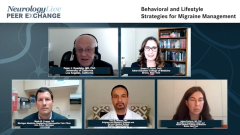
Acute Treatment of Migraine: Progress With Novel Medications
Episodes in this series

The panel reviews outcome expectations for the acute treatment of migraine, and Jelena Pavlovic, MD, PhD, provides insight on her personal experience as both a clinician and migraine sufferer.
Peter J. Goadsby, MD, PhD: Wade, we’ve been talking broadly about these new medicines. Take us through how you might compare triptan development with outcome standards for what we’re using now and how we monitor those.
Wade M. Cooper, DO: We’re building on what we’ve learned over the past couple of decades. Now we’re using pain freedom, both at 2 hours and sustained 24-hour pain freedom. We’ve also invented a new end point for measurement of acute migraine treatments using the most bothersome symptoms. These aren’t what you think. They aren’t anything under the sun. It’s restricted to only 3 subcategories: light sensitivity, sound sensitivity, and nausea.
Those are helpful end points to see what else your acute therapy can do, besides treating the head pain component. Now they’re also looking at acute medication utilization afterward, or redosing, and even more important, some functional outcomes. How functional are people 24 hours after using acute therapy vs using placebo or those types of things?
Peter J. Goadsby, MD, PhD: Yes, exactly. Dawn, you might like to come in on this to discuss functional outcomes, some of the scales that are used, and how meaningful they are to patients
Dawn C. Buse, PhD: Absolutely. Some new functional scales were developed specifically for testing some of the MAD [multiple ascending dose] clinical trials and were accepted by the FDA as end points. Those are the MPFID [Migraine Physical Function Impact Diary] and MFIQ [Migraine Functional Impact Questionnaire], as well as another end point that was more recently accepted by the FDA, which was the subscale of the migraine-specific quality-of-life questionnaire.
There is much more awareness of the need to think about patient-reported outcomes and end points that are important to patients. Peter, I should share with our listeners that you and I are working together on a current FDA grant. We are gathering input from patients—real people living with migraine—about what matters to them and trying to think about how to design clinical trials with the end points that are meaningful and important to those patients.
That’s a goal in the next few years. Together with our colleagues, we hope to move further in that direction. The FDA actually mentioned this more than 10 years ago in a publication, and to their credit, created this whole line of research grants to gather patient end point data, not only for migraine, but for all sorts of clinical disease states. It’s a good direction we’re moving in.
Peter J. Goadsby, MD, PhD: We often criticize the regulators, but you have to give them the credit that they’re not only expressing an interest but actually putting up funds to explore patient-orientated outcomes. It’s the way the world should be. It has to be said. Paul, how do you explain these novel medications to patients? How do you incorporate starting to talk about these with your patients in practice?
Paul G. Mathew, MD: Whenever I’m discussing these medications, I try not to bog it down too much in terms of the mechanisms and the specifics. But I do also tell them that these are migraine specific, as triptans were. I also talk about tolerability and adverse-effect issues. One end point that we didn’t really touch on much, which is very exciting to patients, is return of headache within 24 to 48 hours.
Some of the newer treatments are actually collecting these data, and it is really impressive that many of the subjects in these trials do not have a recurrence of headache in 24, 48, or even 72 hours sometimes. That is really exciting because it could potentially be employed situationally. If there is a patient who will typically get a headache that lasts multiple days after flying, they may consider using 1 of these treatments during those times. That also applies to menstrual headache, when they know they’re going to have a consistent headache for multiple days in a row.
That’s certainly something I pitch to the patients. I also reinforce, as my colleagues mentioned, the importance of timing. This is when referring to the diaries can be tremendously useful. If a patient has an 8-of-10 pain for 6 days in a row, I look at their diaries with them and tell them, “Listen, if you had taken your abortive medication early enough, this could have been a headache that was terminated on day 1, and you may not have had these subsequent headaches on the multiple days thereafter.”
Dawn C. Buse, PhD: But people with migraine have had low expectations for a long time. You think of our grandmothers going to a dark room and putting a cold washcloth on their heads and saying, “It’s OK. I’ll sleep it off.” We think of people 20 years ago, before there were migraine-specific treatments, struggling through. Once there were treatments with either lower tolerability, lower efficacy, or both, people said, “Well, it’s OK. It’s better than nothing. I’m getting by.”
What we can see in the data are high numbers of headache days, high amounts of disability, yet mediocre levels of satisfaction. We’ve actually arrived at this renaissance in which people living with migraine can have efficacy and tolerability and start to raise their expectations a bit.
Peter J. Goadsby, MD, PhD: Exactly. Paul?
Paul G. Mathew, MD: The other thing that’s so encouraging with these newer treatments is that they’re going to help us end hoarding behavior. We’re able to better educate our patients about the importance of early dosing, and patients don’t have to live in fear of running out of their abortive medication.
I can comment on my own practice. For patients who are partial responders to triptans, it’s great to be able to have a rimegepant, ubrogepant, or lasmiditan as their go-to medication. If they run out of that, they still have a triptan as a backup. Patients have not only better therapies but adequate numbers of tablets to be able to survive, which is very powerful.
When patients have 8 tablets of a newer medication and 12 tablets of a triptan, it gives them the confidence to dose early. A lot of the time, that allows them to not have to use the triptan, because they’re dosing early enough that they’re able to terminate the attack.
Dawn C. Buse, PhD: Paul, I imagine that could help not only with medication overuse, but also with anxiety and well-being. When someone feels as if they can count on something, they can start living their life again.
Paul G. Mathew, MD: I know, Dawn. That’s why, since I met you, I can count on living my life again.
Wade M. Cooper, DO: Paul, can you clarify for our listening audience? You’re allowed to combine ditans and triptans. You can combine CGRP-targeted therapies like gepants and triptans, right?
Paul G. Mathew, MD: Yes. Thank you for clarifying, Wade. I do instruct the patients not to take these 2 medications on the same day. I tell them not to use 2 different therapies within a 24-hour period. Thank you for bringing that up. You should absolutely not take triptans and ditans on the same day, and just to conserve medications, I tell them not to take a CGRP antagonist and a triptan on the same day as well.
Wade M. Cooper, DO: Paul, just to look at that even further, is that because you’re worried about a safety issue of those 2 together, or is it more that you’re trying not to complicate their medication treatment history?
Paul G. Mathew, MD: It’s both, actually. We don’t know if taking more than 1 serotonergic agent at once is safe, and certainly I wouldn’t push the buck in that situation. Thank you for that question. That’s a good clarification.
Peter J. Goadsby, MD, PhD: We’re all expressing excitement about new therapies, and we’re all expressing optimism because the clinical trials have been good. It’s 1 thing to have 25 years of experience as we have with the triptans, and we’ve learned to absorb a bit of buffering, so to speak.
We don’t have 25 years’ experience with these new medicines, so we’re encouraging our colleagues to go forward with enthusiasm but not undue speed, and to always be reflective about what we’re doing. We’re going to move from this into some further detail about the future acute treatments.
Newsletter
Keep your finger on the pulse of neurology—subscribe to NeurologyLive for expert interviews, new data, and breakthrough treatment updates.
































